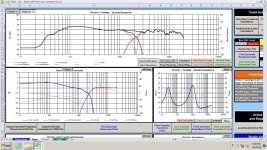Which filter? The 4th order or 8th order?
#138 post. The curve looks like stone dropping from cliff
The RS225 is generally praised for its performance. However, I'm not trying to sell anyone on its use. I'm showing possibilities. I have several Dayton drivers that I consider excellent. I've bought others that didn't meet my needs, and I returned, or sold them years later.OK i will again excuse myself with a warning to @electronicsman to not buy anything until you can go through the entire design process on your own without relying on any files generated by somebody else.
they could have made a mistake and you will end up eating the cost of it unless you can return the driver and crossover parts to the store.
By contrast @A4eaudio did actually build this speaker and made it work but with a 1.4 khz crossover which is an extremely low crossover point for a 1" dome tweeter.
My guess is that if you want to do a 2-way using this 8" driver you will have to go with that low 1.4 khz crossover point, which will put a lot of stress on the tweeter.
If your goal is to simply build something then you could go through with building something similar to what @A4eaudio has built except using a cheaper dome tweeter.
but if you want a high performance system to actually enjoy for at least a few years then this 8" Dayton won't work in a 2-way.
but frankly unless you're willing to build your own box, do a 3-way and use drivers other than Dayton you can't have very high expectations anyway.
Parts Express has a 60 day return policy. There's also 53 five star reviews on their web page for the RS225. I'd like a pair, but the P series is the one I'd probably want. Not sure what I'd build though. I'm currently playing with an RS270p-4. Love it, but it's no longer available.
Last edited:
Well, I got bored waiting for replies, so I made a sim with a tweeter added. This is the very steep slope filter. The slight dip at 3k was intentional. A cap value change fills it in if desired. Mostly, I wanted to see if the steep woofer slope would be difficult to match up with. It was pretty easy. I grabbed an available frd from my computer files. Might be a DC28f. Not sure, and doesn't really matter, as this was just a test.
Attachments
Last edited:
Breakup peaks can be greatly exaggerated when using a response plot. In it's nature, breakup changes with angle. The bigger peak is usually measured on-axis (0 degrees).Why breakup power is less than plot shows? Is there some rule, that simulations are more harsh?
0 degrees represents a tiny amount of the total radiation surface and hence power with regard to omnidirectional radiation. Shown here, the red 0 degree (+/- 5 degrees) is 27dB down in power terms (using 3dB per halving rather than 6dB).
